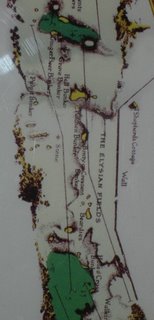18 Holes – Day #10 - 14th at St. Andrew’s (Long)
 How do you pick from all the delightful holes at St. Andrew’s. The back nine alone has the Road hole, the Eden and the 16th is pure inspiration for me. But the 14th hole holds some of the best ideas in golf all in one hole. It is certainly one of the best par fives in golf.
How do you pick from all the delightful holes at St. Andrew’s. The back nine alone has the Road hole, the Eden and the 16th is pure inspiration for me. But the 14th hole holds some of the best ideas in golf all in one hole. It is certainly one of the best par fives in golf.
The tee shot is over whins and gorse, your invited to cut the corner and shorten the hole, but the out of bounds is tight to the right of the fairway. The prudent play is out to the left but you must skirt the Beardies and avoid the wickedly deep little Crescent bunker to find safety in the Elysian Fields. Once safely upon the Elysian Fields you face a fascinating dilemma. Do you play over the incredibly deep and menacing Hell Bunker to shorten the approach, or do you play wide and out to the left of the bunker for safety. It is not very often when one bunker can create the level of fear the Hell Bunker does. Right from the tee you are aware of it’s location and penal nature. Your goal is to stay out at all costs. The most interesting feature to me is the green and the final shot. There is a large wicked roll that begins just off the front of the green and continues through into the front of the green. Nothing is more complicated than trying to get near a front pin. I watched group after group try fly it in and ending up in the back of the green. Finally an old gentlemen played a long bump and run from well out to within 5 feet. I asked him how he knew to do that. He smiled and told me it took him years to figure out there is no other approach to that green and he had to learn to hit the shot.
The most interesting feature to me is the green and the final shot. There is a large wicked roll that begins just off the front of the green and continues through into the front of the green. Nothing is more complicated than trying to get near a front pin. I watched group after group try fly it in and ending up in the back of the green. Finally an old gentlemen played a long bump and run from well out to within 5 feet. I asked him how he knew to do that. He smiled and told me it took him years to figure out there is no other approach to that green and he had to learn to hit the shot.
So what can be learned? First, that a mound can be much trickier and more sinister defense than a bunker. It is a very subtle form of hazard that is very hard to slove because it requires imagination. It befuddles a strong player, yet allows a weaker player an easier approach compared to a bunker – another great equalizer in the game. The Hell Bunker teaches us that a menacing hazard weighs on a golfers mind the entire hole. One bunker can be intimidating enough on it’s own to alter the psyche of the player. The thirds is that interior bunkering can adequately challenge the good player while the wide fairways give the weaker player the opportunity to enjoy the game. Finally even the out of bounds creates a classic diagonal carry providing risk and reward. What an outstanding hole to study.
Next Hole: http://thecaddyshack.blogspot.com/2006/06/18-holes-day-11-13th-at-gleneagles.html

2 comments:
Ian, keep this up - wonderful stuff, thanks.
The St. Andrews' hole reminds me of something I've always thought about TOC: it seems to me that the holes there came first, and the design philosophy second (and not the other way around). That is, that the Scots chose to play the game on land that wasn't much good for much else (like growing food, for example) and that the game of golf developed from that, later on (along with ideas about golf course architecture); or in other words, that the early Scots didn't have some pre-existing idea of what a golf hole should look like or play like. But when I read your description, it sounds like Robertson had a very clear idea about design principles and strategy. Am I reading you right? Do you think that by Robertson's time what we now "see" as design was actually design, and not just lucky happenstance?
Thanks
Peter
The depth of the Hell bunker was because the locals use to dig there for shells. It grew until the golf course put a stop to the practice.
I think the majority of the 14th is natural, and I could have easily put down nature as the architect.
I think your right the Scot's simply played what they found and now we chose to emulate their best strategies. The funny part is often things we won't copy are so much fun to play - just a little unconventional in nature - we have a lot to learn about the game from them.
Nobody can be sure what Robertson did other than the Road hole and widening the fairways.
Post a Comment